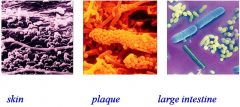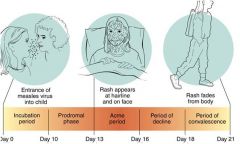![]()
![]()
![]()
Use LEFT and RIGHT arrow keys to navigate between flashcards;
Use UP and DOWN arrow keys to flip the card;
H to show hint;
A reads text to speech;
62 Cards in this Set
- Front
- Back
|
Pathology
|
Study of disease
|
|
|
Etiology
|
Study of the cause of a disease
|
|
|
Pathogenesis
|
Development of disease
|
|
|
Infection
|
Colonization of the body by pathogens
|
|
|
Disease
|
An abnormal state in which the body is not functionally normally
|
|
|
Normal microbiota
|
permanently colonize the host
|
|
|
Transient microbiota
|
may be present for days, weeks, or months
|
|
|
Symbiosis
|
is the relationship between normal microbiota and the host
|
|
|
Commensalism
|
one organism is benefited and the other is unaffected.
Corynebacteria (surface of eye) |
|
|
Mutualism
|
both organisms benefit.
Escherichia coli (vitamin K and some B vitamins) Probiotics : live cultures applied for beneficial effect Lactobacillus |
|
|
Parasitism
|
one organism is benefited at the expense of the other.
(any pathogen) |
|
|
Locations of normal microbiota
|

may act as opportunistic pathogens
Streptococcus pneumoniae Staphylococcus aureus Escherichia coli |
|
|
Probiotics:
|
live microbes applied to or ingested into the body, intended to exert a beneficial effect.
|
|
|
Microbial antagonism
|
is competition between microbes
|
|
|
Koch’s Postulates (etiology of disease)
|
All animals with disease must have suspected agent
Isolate suspected agent and Grow in Pure culture Inoculate healthy susceptible animal which must come down with same disease Re isolate suspected pathogen ex: Bacillus anthracis cause of anthrax |
|
|
Symptom
|
A change in body function that is felt by a patient as a results of disease (pain, malaise)
|
|
|
Sign
|
A change in a body that can be measured or observed as a result of disease. (temperature, swollen lymph)
|
|
|
Syndrome
|
A specific group of signs and symptoms that accompany a disease. (used to diagnose disease together with lab results)
|
|
|
Communicable disease
|
spread from one host to another
ex:chickenpox, measles, genital herpes, AIDS |
|
|
Contagious disease
|
easily spread from one host to another
ex; chickenpox, measles |
|
|
Non communicable disease
|
not transmitted from one host to another rabies, tetanus
|
|
|
Incidence
|
Fraction of a population that contracts a disease during a specific time. (indicator of spread)
ex: 11,724 AIDS cases reported yearly July to June |
|
|
Prevalence
|
Fraction of a population having a specific disease at a given time (old and new cases) indicates how long a disease effects a population
ex: 281,000 living with AIDS in U.S. |
|
|
Sporadic disease
|
occurs occasionally in a population
Hepatitis C viral (51), mumps (40), measles (42) |
|
|
Endemic disease
|
constantly present in a population
tuberculosis in urban areas |
|
|
Epidemic disease
|
acquired by many hosts in a given area in a short time
influenza |
|
|
Pandemic disease
|
worldwide epidemic
AIDS |
|
|
herd immunity
|
Rate of spread and number people affected are determined by immunity. Advantage of vaccination is that if most of population is vaccinated , unvaccinated people will be protected
|
|
|
Acute disease
|
symptoms develop rapidly but lasts short time influenza (influenza virus)
acute bacterial endocarditis (Staophylococcus aureus - mouth) |
|
|
Chronic disease
|
disease develops slowly but likely to be continual or recurrent
ex; infectious mononucleosis (Epstein Barr Virus), tuberculosis (Mycobacterium tuberculosis) hepatitis (Hepatitis B Virus) |
|
|
Latent disease
|
disease with a period of no symptoms when the causative agent is is inactive
ex: shingles (Varicella-Zoster Virus cold sores (Herpes Simplex Virus) |
|
|
Local infection
|
Pathogens limited to a small area of the body (Staphylococcus aureus); boil abscesses)
|
|
|
Systemic infection
|
An infection throughout the body by blood and lymph (measles)
|
|
|
Bacteremia
|
Bacteria in the blood
|
|
|
Septicemia
|
Growth of bacteria in the blood
|
|
|
Toxemia
|
Toxins in the blood (tetanus)
|
|
|
Viremia
|
Viruses in the blood (measles)
|
|
|
Primary infection
|
Acute infection (HIV) that causes the initial illness (AIDS)
|
|
|
Secondary infection
|
Opportunistic infection after a primary (predisposing) infection (Pneumocystis)
|
|
|
Sub clinical disease
|
No noticeable signs or symptoms (inapparent infection)
(Poliovirus, hepatitis A) |
|

The Stages of a Disease
|

|
|
|
Reservoirs
|
continual sources of infection.
|
|
|
Human Reservoirs
|
AIDS, Measles, Poliovirus, Gonorrhea, Diphtheria, Streptococcus
Carriers may have inapparent infections or latent diseases |
|
|
Animal Reservoirs
|
Rabies, Lyme disease, Influenza, Hantavirus
zoonoses disease of lower animals transmitted to humans |
|
|
Nonliving Reservoirs
|
Soil Botulism, Tetanus
|
|
|
Contact Transmission
|
Direct Requires close association between infected and susceptible host
Indirect Spread by fomites (contaminated inanimate objects) Droplet Transmission via airborne droplets (< meter) |
|
|
Vehicle Transmission
|
inanimate reservoir (food, water, air > 1 meter)
Salmonella, Cholera, Shigellosis, Mycobacterium, Staphylococcus, Streptococcus |
|
|
Vector Transmission
|
arthropods, especially fleas, ticks, and mosquitoes
Malaria, Lyme disease, RMSF, Dengue fever) Mechanical- Arthropod carries pathogen on feet Biological- Pathogen reproduces in vector |
|
|
Salmonella
Transmission |
Salmonella
direct (shaking hands), indirect (fomite), vehicle (food), vector (flies) 4F’s : flies, fingers, food, feces |
|
|
Nosocomial
|
(Hospital-Acquired) Infections
acquired as a result of a hospital stay 5-15% of all hospital patients acquire nosocomial infections contributing factors virulence factors antibiotic resistance Compromised Host Chain of transmission Dr. Nurses |
|
|
Most common Nosocomial infection
|
UTI
|
|
|
Emerging Infectious Diseases
|
Diseases that are new (AIDS), previously seen increasing in incidence (TB), or diseases not seen in this country (West Nile Encephalitis)
|
|
|
Contributing factors of Emerging Infectious Diseases
|
Evolution of new strains (Vibrio cholerae O139, Invasive group A Streptococcus (flesh eating)
Human Intervention (Bolivian hemorrhagic fever viruses, HIV-AIDS, Ebola hemorrhagic fever) Inappropriate use of antibiotics nosocomial Methicillin resistant Staphylococcus aureus and Vancomycin resistant Enterococci XDR extensively drug resistant Tuberculosis Changes in weather patterns (Hantavirus Pulmonary Syndrome) Modern transportation (West Nile fever) poverty, war, expanding human settlement (Dengue Hemorrhagic fever) Animal control measures (Lyme disease, Bovine Spongiform Encephalopathy (prion) Public Health failure (Escherichia coli O157:H7, Diphtheria |
|
|
Epidemiologists
|
Study factors and patterns of people affected
age, sex, occupation, habits, socioeconomic, immunization other diseases, common history of affected individuals Site at which host had contact (where) Time period of disease (when) ex: seasonal or yearly basis Control drugs, vaccines, animal control, water treatment sewage disposal, pasteurization, food inspection |
|
|
John Snow
|
Collection and analysis of data regarding occurrence of disease
Retrospective - looking back Mapped the occurrence of cholera in London Descriptive Epidemiologist |
|
|
Ignaz Semmelweis
|
Study of a disease using controlled experiments
Hypothesis and test hypothesis Showed the hand washing decreased the incidence of puerperal fever Experimental Epidemiologist |
|
|
Florence Nightingale
|
Comparison of a diseased group and a healthy group
Showed that improved sanitation decreased the incidence of epidemic typhus Analytical Epidemiologist |
|
|
Centers for Disease Control and Prevention (CDC)
|
Collects and analyzes epidemiological information in the U.S.
Case reporting : Health care workers report specified disease to local, state, and national offices Nationally Notifiable Diseases : Physicians are required to report occurrence in MMWR Publishes Morbidity and Mortality Weekly Report (MMWR) occurrence, incidence of Nationally notifiable diseases |
|
|
Morbidity:
|
incidence of a specific notifiable disease
|
|
|
Mortality
|
deaths from notifiable diseases
|
|
|
Morbidity rate
|
number of people affected/total population in a given time period
|
|
|
Mortality rate
|
number of deaths from a disease/total population in a given time
|

